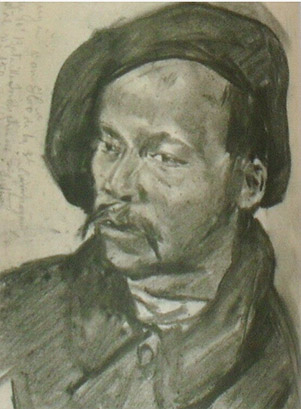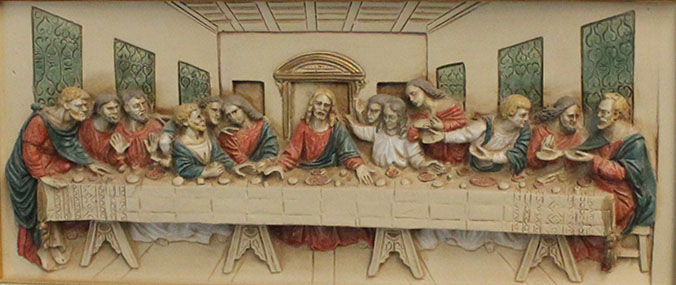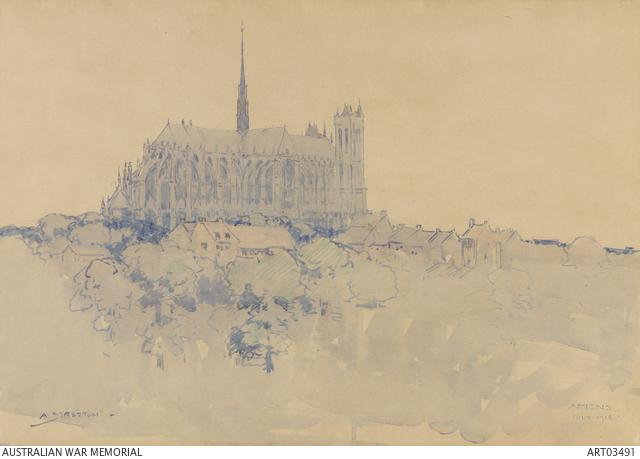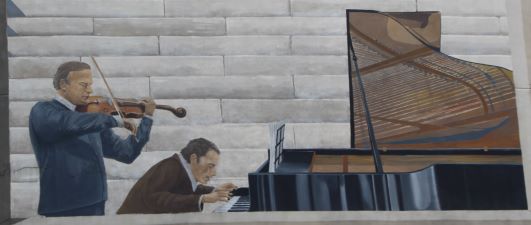 - Welcome - Painting
- Welcome - Painting
Drawing and Painting
Art of Drawing
Drawing is the art of representing a figurative or abstract form on a surface. This technique gave rise to many ways of depicting the stroke using different instruments, such as pencils, chalk, charcoal, pastels, pens, ink, and brushes.
Charcoal drawing
Charcoal is a drawing whose line is more or less blurred. It also designates the pencil available in different models, from the hardest to the most flexible, and it can be brittle if the pressure exerted is too great. The intermediate version looks like the HB pencil, as we all know. It is a realization full of nuances, an exercise in shadows, and even the eraser is used to achieve the gradient.
Lucien Hector Jonas (1880-1947) was a native of Valenciennes. He did considerable work on the portraits of soldiers during the War of 14-18 with the charcoal technique. Identification of these soldiers is possible due to the name or unit being sometimes specified directly on the drawings. He became a military painter in 1915, and he produced paintings such as those for the single command room located at the town hall of Doullens. He was appointed the official painter of the Navy in 1916.
He had been solicited for the Universal Exhibition in Paris in 1937. He made a tapestry box in 1942 for the Gobelins factory. His works are known all over the world, from America to Asia and also to the royal palace in Bangkok.


Courtesy of M. Jean-Paul Fontanon. ©
These soldiers' portraits of charcoal made during the war by Lucien Jonas have been grouped in several volumes under the French title of "Fusains de la Grande Guerre" by Mr. Jean-Paul Fontanon - Edition JPFo.
Drypoint
Drypoint is an engraving process requiring the use of a pencil-like drypoint but with a sharp tip. These tools exist in different dimensions.
Shallow lines were drawn on a copper or zinc plate. The way to engrave these lines determines the sharpness or blur of the final drawing. The stone burnisher makes it possible to repolish, to rectify a clumsy gesture on this plate.
The ink was applied to the plate with a roller to cover all the grooves previously engraved. The pattern must be drawn upside down because the print board is placed on the plate covered with ink before passing under the press.
The drawer Charles Samson (1893-1978), a native of Villers-Bretonneux, had produced several planks with a drypoint. He drew monuments and cathedrals of Amiens, Reims, Notre Dame de Paris, views of the Seine, Montmartre, mansions, bridges of the Loire, castles of the Loire Valley, and several buildings of its region of origin, such as the castle of St-Gratien.

A castle in the north of France by M. Charles Samson - Photo credit private collection
Aboriginal painting
Aboriginal culture is one of the oldest cultures in the world, whose purpose is to transcribe ancestral traditions. Objects such as boomerangs and didgeridoos with this particular sound are part of this heritage. The Aboriginal painting was realized on several supports such as cave walls, sand, and soil. The first rock paintings were applied on cave walls, represented on tree bark, and more recently on fabrics. |
|
The popularity of this primitive art developed in the 80s with some exhibitions and the creation of several museums in Europe and around the world. The Quai Branly Museum was designed by Jean Nouvel and was inaugurated by Jacques Chirac passionate about primitive arts, in 2006. How did they get the idea of rendering their culture in this way, at a time when the pencil did not exist?
Arnhem Land in the north of Australia is rich in rock paintings. The site of the Murujuga peninsula near Dampier has the largest complex of rock engravings.
Each Aboriginal community has a different way of illustrating its own culture. Each symbol has a specific meaning, water for example is represented by many patterns such as rainwater, running water, the points of convergence of water, or even the billabong, a point of water that never dries, an essential landmark during the dry season.
Aboriginal artists from the north of Australia came to Paris, to share their traditional stories and knowledge in the exhibition called Jarracharra, by featuring their textile art at the Australian embassy in Paris in January 2020.
Jarracharra: Dry Season Winds, a collection of textile works produced by Aboriginal women artists from the Babbarra Women's Center.


"Dry season winds" - Australian Embassy in Paris.
The tempera painting
Tempera or tempera painting consists of using diluted pigments. This method has been abandoned in favor of oil painting.
This technique was used by Leonardo da Vinci, for the realization of one of his major works, namely The Last Supper. (cena in Latin). He used oil on a plaster preparation to make this fresco, which measures 4.60 m high and 8.80 m wide. This work was painted in the hall of the refectory of the Convent of Santa Maria Delle Grazie. The room is kept at a constant temperature with a small number of visitors so as not to damage it further. In this work, Leonard wanted to catch the different human emotions through the posture of these disciples, wondering about the next betrayal announced.
There are many interpretations of this scene, including a tapestry done at the request of King François I, made of silk, gold, and silver threads.

A version of the Last Supper by Vinci.
Oil painting
Oil paint is made up of pigments linked to a vegetable oil such as linseed oil, which has the particularity of drying more quickly, and the essence of turpentine serves as a thinner.
The first Flemish painters used specific varnishes for the preservation of their canvases. This painting developed around the 15th century.
The famous Caravaggio, with an eventful destiny, produced many works in oil paint, with the ability to create contrast and chiaroscuro remarkable. He used several treatments to cover the shadows and the dark backgrounds.

The knight Alof Wignacourt, painted between 1607 1608 by Caravaggio,
displayed at the Louvre museum in Paris.
Icon painting
Icon painting is the art of representing a religious portrait, and it’s a symbol of peace. Although iconography responds to strict rules and a perspective, the diversity of styles is large. All details are studied, as well as the choice of colors.
The traditional background of icons is made of levkas, a mixture made mainly of sturgeon glue and white chalk. The icon is drawn and then painted with dark colors to finish with the lighter ones.
Sofia Atlantova and Oleksandr Klymenko, from Kyiv, painted icons on ammo boxes. These paintings were the subject of a first exhibition in Kyiv at the beginning of 2015 and then in other countries afterward. The funds raised were used to finance a mobile hospital.
![]()
Mary mother of God
Impressionist painting
Impressionist painting, as its name suggests, aimed to represent the impression of the moment. Claude Monet was the most iconic painter of this new way of painting, but others have followed this movement.
Arthur Streeton was a famous Australian impressionist painter. He got used to painting in the daylight outside. His brushstrokes were fragmentary and a little foggy. His goal was to capture the atmosphere, the visual impression of the moment, as he did for the Amiens landscape during the First World War. He was appointed as an official war artist by the Australian War Memorial.

Amiens Cathedral by Arthur Streeton, credit photo AWM ART03491
Mural painting
The purpose of mural painting is to embellish exterior or interior walls. In general, the painting is carried out directly on the wall. Some works are painted in the workshop on a synthetic fiber canvas and then pasted to the wall.
The fresco is a mural painted on a fresh coating. The word comes from the Italian word fresco, meaning fresh. In addition to the decorative aspect, this gives life to more or less dull spaces, and the whole atmosphere of the place is transformed.
The fresco below was made by Fabio Rieti, who was a trompe-l'oeil specialist. It was restored in 2016 by his daughter and granddaughter, Louyz, a painting enthusiast.

Yehudi and Glenn Gould ...

... and the instruments are perfectly depicted as well.
Pastel painting
A pastel painting consists of soft tones. It contains mineral, organic, and vegetable pigments combined with a binder and chalk or plaster.
This genre of painting is known to transcribe light quite faithfully. Many portraits were painted with this technique, which is close to drawing and painting. The pencil lines are blurred, or several layers of paint are superimposed.
Mr. Maurice Quentin, originally from Saint-Quentin in the Aisne, was renowned for his know-how in pastels. He had succeeded in developing a process for fixing the pastel.
Poulbots
Les Poulbots, in common parlance, is the name given to the paintings of the children of Montmartre in the neighborhood of Sacré-Coeur Basilica in Paris.
They are depicted with large eyes, scarlet cheeks, and bright colors. This popular style has inspired many painters in different forms, such as paintings, postcards, accessories, etc.
They were born under the hand of Francisque Poulbot, the son of teachers who care about these underprivileged children.

Poulbot Painting
Still-life painting
The still life is a subject of a low material value at the base, which the painter brings to light through painting. Therefore, the value of the painting lies in the interpretation and the talent of the painter. This involves working on tones, mixing bright colors, working reflections or shadows, and accentuating or attenuating a few elements.
Floris Van Dyck from Dutchland was known for his still-life painting, mostly of food arranged on a draped table. These elements seem laid out carelessly on the table, yet every detail was carefully considered, such as the choice of the delicately embroidered tablecloth.

Credit photo - Netherlands Institute for Art History.
Watercolor painting
Watercolor painting is made up of crushed pigments and gum arabic. Its name is derived from the Italian word aqua, referring to water, which is used to dilute it. The effect obtained is relatively light and clear. The shade of colors is worked in different ways, like the glacis technique, which consists in applying several layers of colors.
Watercolor was in vogue during the Renaissance, in particular, to illustrate the works of archeology, geography, geology, ornithology, and so on. However, this painting is ancient, akin to cave paintings, and its appeal is undeniable.


